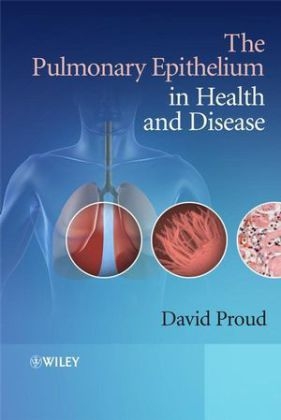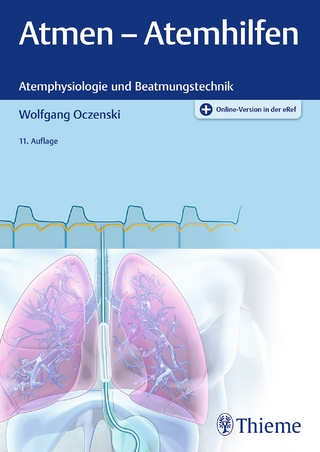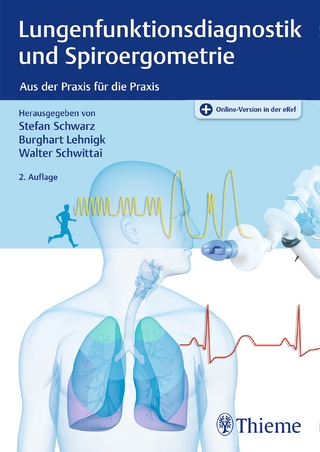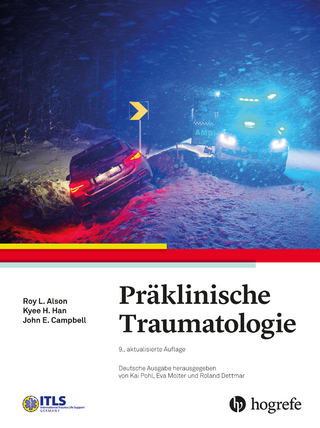
The Pulmonary Epithelium in Health and Disease
John Wiley & Sons Inc (Verlag)
978-0-470-05951-7 (ISBN)
"This is essential reading for everyone who would like to update their knowledge of the pulmonary epithelium. It offers a comparison between laboratory animal models and human lungs, highlighting the differences and the similarities between the two, which will be particularly useful to researchers." –Doody's, April 2009
The past two decades have seen extraordinary advances in our understanding of the role of the pulmonary epithelium in airway health and disease. Our understanding of epithelial biology has expanded exponentially in the past decade.
This book provides a unique comprehensive description of the structure of the epithelium, its damage by various agents and the mechanism of epithelial repair. In addition, it's detailed coverage includes not only the multiple ways in which the epithelium contributes to host defence, but also the nature and functional consequences of the interactions of inhaled pathogens, including viruses, bacteria, allergens and pollutants. the role of the epithelium in regulating airway inflammation and structure is also discussed, as is the role of the epithelium as a target for inhaled medications and as a route for novel drug delivery.
Containing chapters on multiple aspects of epithelial function in health and disease, each one is written by a leader in the field. This is essential reading for pulmonary researchers and physicians requiring detailed advanced understanding of the epithelium as well as those working in allergy, biomedical and pharmaceutical research.
David Proud, Professor and Head, Department of Physiology & Biophysics, University of Calgary, Canada.
Preface. List of Contributors.
1. Pulmonary Epithelium: Cell Types and Functions (Mary Mann-Jong Chang, Laura Shih and Reen Wu).
1.1 Introduction.
1.2 Epithelial cell types and functions in the cartilaginous proximal airway region.
1.3 Epithelial cell types and functions of the non-cartilaginous distal bronchioles.
1.4 Epithelial cell types and functions of the gas exchange region.
1.5 Circulating stem cells and applications in lung regenerative medicine.
1.6 Stem cell therapy: embryonic or adult?
1.7 Conclusion.
2. Epithelial Adhesive Structures and Adhesion Molecule Expression(George Su and Dean Sheppard).
2.1 Introduction.
2.2 Cell–cell adhesive structures.
2.3 Cell–substratum adhesion.
2.4 Conclusion.
3. The Epithelium as a Target (Louise E. Donnelly).
3.1 Introduction.
3.2 Asthma.
3.3 Alteration in epithelial cell type distribution.
3.4 Overview of epithelial damage in asthma.
3.5 Chronic obstructive pulmonary disease.
3.6 Effect of cigarette smoke.
3.7 Other causative factors.
3.8 Alveolar epithelial cell apoptosis – emphysema.
3.9 Overview of epithelial damage in COPD.
3.10 Damage to the epithelium in other diseases.
3.11 Conclusions.
4. Epithelial Repair and Function (Carl G. A. Persson, Morgan Andersson and Lena Uller).
4.1 Brief introduction to epithelial shedding-repair and associated functions in health and disease.
4.2 Repair following shedding of single columnar epithelial cells and following shedding of clusters of columnar cells.
4.3 Epithelial denudation.
4.4 Pharmacology of epithelial repair.
4.5 Epithelial shedding-restitution as a causative process in airway inflammation and remodelling.
5. Integration of Epithelial Ion Transport Activities into Airway Surface Liquid Volume and Ion Composition Regulation (Mark T. Clunes, Peter F. Bove and Richard C. Boucher).
5.1 Introduction: the role of fluid in airway/alveolar physiology.
5.2 Model of ion and solute transport through airway epithelia.
5.3 Airway histology.
5.4 Airway ion secretion.
5.5 The cystic fibrosis transmembrane conductance regulator.
5.6 Calcium-activated chloride channels.
5.7 K+ channels.
5.8 Airway ion absorption.
5.9 Measurement of ion and water transport in airway epithelia.
5.10 In vivo transepithelial PDs.
5.11 Volume flow measurements.
5.12 Physiologically ‘thin film’ measurements of ASL volume regulation with confocal microscopy and microelectrodes: studies of normal and CF airway epithelia.
5.13 The role of physiologic airway shear-stress in ion transport and ASL regulation.
5.14 Fluid transport across the alveolar epithelium.
6. Structure and Function of Cilia (Andreas Schmid and Matthias Salathe).
6.1 Introduction.
6.2 Structure.
6.3 Function.
6.4 Ciliary dysfunction associated with disease.
7. Composition and Function of Airway Mucus (Duncan F. Rogers).
7.1 Airway ‘mucus’.
7.2 Respiratory tract mucins.
7.3 Mucin genes and gene products.
7.4 MUC5AC.
7.5 MUC5B.
7.6 Airway mucus hypersecretory phenotype in COPD.
7.7 Airway mucus hypersecretory phenotype in asthma.
7.8 Mucociliary clearance in asthma and COPD.
7.9 Mechanisms of airway goblet cell hyperplasia.
7.10 Differences in mucus hypersecretory phenotype between asthma, COPD and CF.
7.11 Conclusions.
8. The Pulmonary Surfactant System (Nicole A. Rocca, Ruud A.W. Veldhuizen and James F. Lewis).
8.1 Overview.
8.2 Surfactant Composition.
8.3 Surfactant Function.
8.4 Normal surfactant metabolism.
8.5 Summary: surfactant in normal lungs.
8.6 Surfactant in lung injury.
8.7 NRDS.
8.8 ARDS.
8.9 Exogenous surfactant therapy – current status and future potential.
9. Microbial Recognition by Epithelium (Catherine M. Greene and Stephen G. J. Smith).
9.1 Introduction.
9.2 TLRs – identification and structure.
9.3 TLR agonist recognition and specificity.
9.4 Airway epithelial cells, PRR polymorphisms and inflammatory lung disease.
9.5 TLR expression in airway epithelial cells.
9.6 Intracellular signalling.
9.7 Functional responses to TLR activation in pulmonary epithelium.
9.8 Non-TLR transmembrane receptors.
9.9 Intracellular PRRs.
9.10 Host-derived PRR agonists.
9.11 Conclusion.
10. Epithelial Antimicrobial Molecules (Pieter S. Hiemstra).
10.1 Antimicrobial peptides and proteins.
10.2 Reactive oxygen and nitrogen intermediates.
10.3 Concluding remarks.
11. The Epithelium and Immunoregulation (Angela Rate and John W. Upham).
11.1 Introduction.
11.2 The pulmonary epithelium and dendritic cells.
11.3 The pulmonary epithelium and lymphoid cells.
11.4 The pulmonary epithelium and T-Cells.
11.5 The pulmonary epithelium and gamma/delta T-cells.
11.6 The pulmonary epithelium, B-cells and IgA production.
11.7 Conclusions.
12. Interactions of Respiratory Viruses with the Epitheliumb(Umadevi S. Sajjan, Dawn C. Newcomb, Toby C. Lewis, Christine S. Stahle and Marc B. Hershenson).
12.1 Introduction.
12.2 Causes of bronchiolitis and community-acquired pneumonia in infants, children and older adults.
12.3 Viruses implicated in the exacerbation of asthma and COPD.
12.4 Upper and lower respiratory tract infections.
12.5 The innate immune response.
12.6 Rhinoviruses.
12.7 Respiratory syncytial virus.
12.8 Influenza.
12.9 Interactions between viral infections and other stimuli.
13. Bacterial Interactions with the Airway Epithelium (Marisa I. Gómez and Alice Prince).
13.1 Introduction.
13.2 Bacterial pneumonia.
13.3 Bacterial virulence factors: role in lung colonization.
13.4 Bacterial recognition by airway epithelial cells.
13.5 Airway epithelial cell responses to bacteria.
13.6 Signaling pathways involved in chemokine and cytokine production by epithelial cells.
13.7 Regulation of inflammation by epithelial cells – receptor shedding.
13.8 Lung damage and bacterial invasion of the airway epithelium.
13.9 Conclusions.
14. Interactions of Pollutants with the Epithelium (Ernst Wm. Spannhake).
14.1 Introduction.
14.2 Oxidant pollutants.
14.3 Particulate matter.
14.4 Secondhand cigarette smoke.
14.5 Conclusions.
15. Interactions between Allergens and the Airway Epithelium (Clive Robinson and Jihui Zhang, Geoffrey A. Stewart).
15.1 The airway epithelium as a key target of allergens.
15.2 The epithelial barrier.
15.3 Peptidases and epithelial cell signalling.
15.4 The biochemical properties of allergens and their contribution to allergenicity.
15.5 Peptidase contributions to allergic sensitization via the epithelium.
15.6 Conclusions.
16. The Epithelium as a Regulator of Airway Inflammation (Richard Leigh and David Proud).
16.1 Introduction.
16.2 Epithelial production of cytokines, growth factors and chemokines.
16.3 Epithelial production of lipid mediators.
16.4 Epithelial production of peptide mediators.
16.5 Epithelial production of reactive nitrogen and oxygen species.
16.6 Epithelial production of proteases.
16.7 The role of epithelial cells in the recruitment of inflammatory cells.
16.8 Anti-inflammatory actions of epithelial cells.
16.9 Summary.
17. The Epithelium and Airway Remodelling (Stephen T. Holgate).
17.1 The epithelium and airway remodelling.
17.2 Epithelial injury and impaired repair.
17.3 Changes to the epithelial laminar reticularis (basal laminar).
17.4 Submucosal smooth muscle adventitial deposition of matrix.
17.5 Airway smooth muscle.
17.6 Vascular remodelling.
17.7 Neural networks.
17.8 Production of mucus.
17.9 Concluding comments.
18. Modulation of Epithelial Cell Function by Glucocorticoids: Anti-inflammatory and Other Effects (Robert Newton, Manminder Kaur, Elizabeth M. King, Wei Gong, Donna M. Slater and Neil S. Holden).
18.1 Introduction.
18.2 Expression of inflammatory genes by epithelial cells is reduced by glucocorticoids.
18.3 Modulation of transcription by GR at simple GREs.
18.4 Inflammatory genes contain binding sites for transcriptional activators and these mediate glucocorticoid-dependent repression.
18.5 Nuclear events mediate transrepression.
18.6 Transactivation plays an important anti-inflammatory role.
18.7 Post-transcriptional effects and a role for glucocorticoid-dependent gene expression.
18.8 MKP-1, an anti-inflammatory glucocorticoid-inducible gene.
18.9 Other glucocorticoid-inducible genes with anti-inflammatory potential in the epithelium.
18.10 Effect of glucocorticoids on lipid mediator production by epithelial cells.
18.11 Remodelling, viruses, glucocorticoids and the epithelium.
18.12 Ion and other channels in the epithelium and the effect of glucocorticoids.
18.13 Maturation of the fetal airway epithelium.
18.14 Non-genomic actions of glucocorticoids.
18.15 Summary.
19. The Airway Epithelium as a Target for the Therapeutic Actions of ß2-Adrenoceptor Agonists and Muscarinic-receptor Antagonists (Mark A. Giembycz).
19.1 Introduction.
19.2 The ß2-adrenoceptor as a therapeutic target.
19.3 The muscarinic receptor as a therapeutic target.
19.4 Concluding remarks.
20. Pulmonary Delivery of Novel Therapies (Bruce Rubin and James B. Fink).
20.1 Introduction.
20.2 Drug targeting.
20.3 Removal of aerosol particles from the lung.
20.4 Barriers to drug absorption from the lung.
20.5 Specific proteins.
20.6 Conclusions.
Index.
| Erscheint lt. Verlag | 1.6.2008 |
|---|---|
| Verlagsort | New York |
| Sprache | englisch |
| Maße | 174 x 250 mm |
| Gewicht | 921 g |
| Einbandart | gebunden |
| Themenwelt | Medizinische Fachgebiete ► Innere Medizin ► Pneumologie |
| Naturwissenschaften ► Biologie ► Mikrobiologie / Immunologie | |
| ISBN-10 | 0-470-05951-6 / 0470059516 |
| ISBN-13 | 978-0-470-05951-7 / 9780470059517 |
| Zustand | Neuware |
| Informationen gemäß Produktsicherheitsverordnung (GPSR) | |
| Haben Sie eine Frage zum Produkt? |
aus dem Bereich


